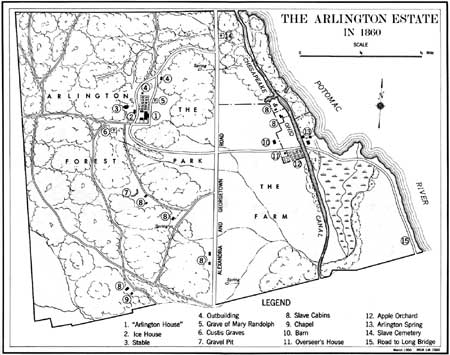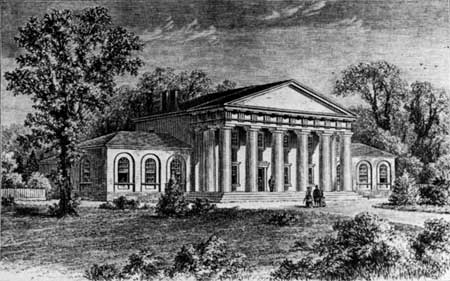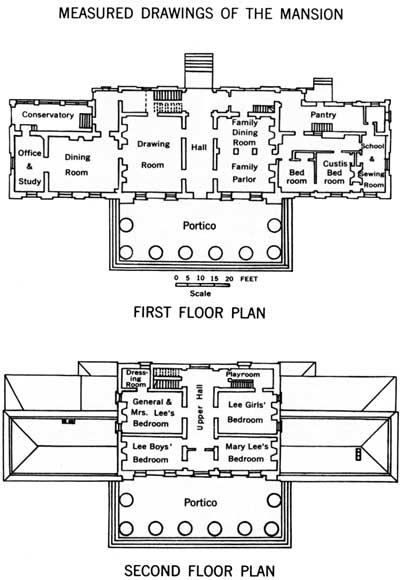|
CUSTIS-LEE MANSION The Robert E. Lee Memorial |
 |

The Arlington Estate in 1860.
(click on image for an enlargement in a new window)
Guide to the House and Grounds
THE OLD ARLINGTON ESTATE. Arlington was but one of several estates totaling more than 15,000 acres owned by George Washington Parke Custis, father-in-law of General Lee. Since the former's income was largely derived from two large farms on the Pamunkey River in New Kent County, Va., he kept Arlington mainly as a gentleman's country estate after the English fashion. The greater part of Arlington was taken up by "the Park," a virgin woodland of ancient oaks and beautiful groves of walnut, chestnut, and elm trees, extending from the Georgetown and Alexandria Road at the foot of the hill clear to the western edge of the estate.
On the level land lying between the road and Potomac River was "the Farm," consisting of an orchard and several large cultivated fields and pastures. Here was grown most of the grain and vegetables required by the Arlington household and the large number of slaves, the surplus being sold in the Washington markets. In the southeast corner of the farm was the Arlington landing, where the barge which hauled produce to market was kept, as well as the schooner Lady of the Lake, used to carry goods to and from the distant farms. Here also docked the steam boats Arlington Belle and the G. W. P. Custis, which annually ferried thousands from the city to the famed Arlington Spring, for half a century a favorite picnic spot for Georgetown and Washington residents. For their convenience the hospitable owner erected pavilions for dining and dancing, requiring only that no liquor be used. Custis considered himself primarily a farmer, and spent most of each day riding or walking about the estate supervising the work being done. After he died in 1857 and the management of the estate was taken over by Col. Robert E. Lee, the area under cultivation was considerably enlarged.

"Arlington House" from a sketch made before 1861, though not
published until 1875.
Arlington originally had been part of a tract of 6,000 acres granted in 1669 by Governor William Berkeley of Virginia to a ship's captain, named Robert Howsing, in payment for transporting settlers to the colony. Howsing soon sold his grant to John Alexander, after whom Alexandria, Va., is named, reportedly for six hogsheads of tobacco. The land remained in the Alexander family until 1778, when John Parke Custis bought 1,100 acres from Gerard Alexander with the intention of establishing a family seat. He died, however, before he had done any thing with the property, whereupon it passed to his son, George Washington Parke Custis, who developed it as described.

THE MANSION. For all its imposing appearance when seen at a distance, the real size of the mansion is not apparent until seen close at hand. The central part of the building is 2 stories high, 60 feet wide, and 40 feet deep. One-story wings, each 40 feet long and 25 feet wide, extend to the north and south, making the length of the entire building 140 feet. In the rear are still lower wings for service and a conservatory.
Although the wings with their tall recessed windows and balustrade are quite pleasing, the magnificent portico is the salient architectural feature of the mansion one of the earliest and best-known examples of Greek Doric porticos in America. This extends 25 feet from the front of the house and has 8 columns 23 feet high and somewhat over 5 feet thick at the base. Early authorities differ as to whether the portico was derived from the smaller, well-proportioned Greek temple at Athens known as the Theseum, or the larger, more imposing temple of Neptune at Paestum, Italy. There is no doubt, however, as to the effectiveness of the architectural style chosen, for no other would have had the strength and massiveness necessary to make the building impressive when viewed from across the river. Yet for all its simplicity and solidity, the proportions of the mansion are so refined as to make it an outstanding example of Greek Classic Revival architecture of the early nineteenth century.
The building is of the most solid construction throughout. All the walls and most of the foundations are of brick, as are the columns of the portico. All of the brickwork exposed to the weather is protected by hard stucco plaster scored with lines in imitation of cut stone. Joists, studs, and rafters are of hewn timber and are neatly mortised together or pinned with wooden pegs, scarcely any nails being used. Doors, cornices, and other woodwork are of pine. The main roof is supported by great barnlike trusses which span the entire width of the center section and originally was covered with wooden shingles, now replaced by slate. At one time the portico columns were painted to look like marble, but later were made white for better contrast with the warm buff or ochre color of the remainder of the house. Well constructed to begin with, the deterioration inevitable in any old building was entirely corrected when the War Department restored the building. Careful maintenance now assures a long and useful future for the Custis-Lee Mansion.

|
|
Last Modified: Mon, Dec 2 2002 10:00:00 am PDT |


